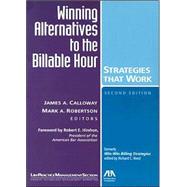
| Foreword by the President of the ABA | vii | ||||
| Preamble | ix | ||||
| Acknowledgments | xi | ||||
| Introduction | xiii | ||||
| Chapter 1: The Search for the Meaning of Value | 1 | (6) | |||
|
1 | (1) | |||
|
2 | (1) | |||
|
3 | (2) | |||
|
5 | (2) | |||
| Chapter 2: The Changing Legal Profession | 7 | (16) | |||
|
8 | (1) | |||
|
9 | (2) | |||
|
11 | (1) | |||
|
12 | (1) | |||
|
13 | (1) | |||
|
14 | (1) | |||
|
15 | (5) | |||
|
20 | (1) | |||
|
21 | (2) | |||
| Chapter 3: Ethical Rules and Practices | 23 | (8) | |||
|
23 | (2) | |||
|
25 | (1) | |||
|
26 | (5) | |||
| Chapter 4: Pricing Legal Services | 31 | (24) | |||
|
31 | (6) | |||
|
37 | (13) | |||
|
50 | (1) | |||
|
51 | (4) | |||
| Chapter 5: Pricing Legal Services for the Solo and Small-Firm Lawyer | 55 | (12) | |||
|
56 | (5) | |||
|
61 | (1) | |||
|
61 | (3) | |||
|
64 | (1) | |||
|
65 | (1) | |||
|
66 | (1) | |||
| Chapter 6: Foundations on Which to Build a Billing Method | 67 | (18) | |||
|
67 | (3) | |||
|
70 | (1) | |||
|
70 | (1) | |||
|
71 | (1) | |||
|
72 | (3) | |||
|
75 | (2) | |||
|
77 | (1) | |||
|
78 | (2) | |||
|
80 | (1) | |||
|
81 | (1) | |||
|
82 | (1) | |||
|
83 | (2) | |||
| Chapter 7: Billing as Part of the Communication Process | 85 | (20) | |||
|
85 | (2) | |||
|
87 | (4) | |||
|
91 | (4) | |||
|
95 | (4) | |||
|
99 | (2) | |||
|
101 | (2) | |||
|
103 | (1) | |||
|
103 | (2) | |||
| Chapter 8: Technology and Billing | 105 | (14) | |||
|
105 | (7) | |||
|
112 | (1) | |||
|
113 | (2) | |||
|
115 | (1) | |||
|
116 | (1) | |||
|
116 | (1) | |||
|
117 | (2) | |||
| Chapter 9: Developing the Case Plan or Transaction Plan | 119 | (6) | |||
|
119 | (2) | |||
|
121 | (1) | |||
|
122 | (1) | |||
|
122 | (2) | |||
|
124 | (1) | |||
| Chapter 10: Alternative Methods of Billing | 125 | (22) | |||
|
125 | (2) | |||
|
127 | (1) | |||
|
128 | (2) | |||
|
130 | (2) | |||
|
132 | (1) | |||
|
133 | (2) | |||
|
135 | (1) | |||
|
136 | (1) | |||
|
137 | (2) | |||
|
139 | (1) | |||
|
140 | (1) | |||
|
141 | (1) | |||
|
142 | (1) | |||
|
143 | (2) | |||
|
145 | (2) | |||
| Chapter 11: Implementing Value-Based Billing | 147 | (18) | |||
|
148 | (1) | |||
|
149 | (2) | |||
|
151 | (2) | |||
|
153 | (2) | |||
|
155 | (1) | |||
|
156 | (5) | |||
|
161 | (1) | |||
|
162 | (2) | |||
|
164 | (1) | |||
| Chapter 12: Legal Representation Agreements | 165 | (4) | |||
|
165 | (3) | |||
|
168 | (1) | |||
| Chapter 13: Evaluating Results of the Use of Alternative Billing Methods | 169 | (6) | |||
|
169 | (1) | |||
|
170 | (2) | |||
|
172 | (1) | |||
|
172 | (1) | |||
|
172 | (2) | |||
|
174 | (1) | |||
| Appendix: Fee Letters, Agreements, and Other Resources | 175 | (100) | |||
| Index | 275 | (10) | |||
| About the Editors | 285 | (2) | |||
| About the Diskette | 287 |
The New copy of this book will include any supplemental materials advertised. Please check the title of the book to determine if it should include any access cards, study guides, lab manuals, CDs, etc.
The Used, Rental and eBook copies of this book are not guaranteed to include any supplemental materials. Typically, only the book itself is included. This is true even if the title states it includes any access cards, study guides, lab manuals, CDs, etc.